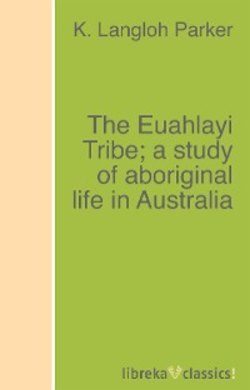The Euahlayi Tribe; a study of aboriginal life in Australia

Реклама. ООО «ЛитРес», ИНН: 7719571260.
Отрывок из книги
No introduction to Mrs. Langloh Parker's book can be more than that superfluous 'bush' which, according to the proverb, good wine does not need. Our knowledge of the life, manners, and customary laws of many Australian tribes has, in recent years, been vastly increased by the admirable works of Mr. Howitt, and of Messrs. Spencer and Gillen. But Mrs. Parker treats of a tribe which, hitherto, has hardly been mentioned by anthropologists, and she has had unexampled opportunities of study. It is hardly possible for a scientific male observer to be intimately familiar with the women and children of a savage tribe. Mrs. Parker, on the other hand, has had, as regards the women and children of the Euahlayi, all the advantages of the squire's wife in a rural neighbourhood, supposing the squire's wife to be an intelligent and sympathetic lady, with a strong taste for the study of folklore and rustic custom. Among the Zulus, we know, it is the elder women who tell the popular tales, so carefully translated and edited by Bishop Colenso. Mrs. Parker has already published two volumes of Euahlayi tales, though I do not know that I have ever seen them cited, except by myself, in anthropological discussion. As they contain many beautiful and romantic touches, and references to the Euahlayi 'All Father,' or paternal 'super man,' Byamee, they may possibly have been regarded as dubious materials, dressed up for the European market. Mrs. Parker's new volume, I hope, will prove that she is a close scientific observer, who must be reckoned with by students. She has not scurried through the region occupied by her tribe, but has had them constantly under her eyes for a number of years.
.....
Yet they are said to lack entirely that belief in a moral and kindly 'All Father,' such as Byamee, which Mrs. Parker describes as potent among the less advanced Euahlayi, and which Mr. Howitt has found among non-coastal tribes of the south-east, with female descent of the totem, but without matrimonial classes—that is, among the most primitive tribes of all.
Here occurs a remarkable difficulty. Mr. Howitt asserts, with Mr. Frazer's concurrence, that (in Mr. Frazer's words) 'the same regions in which the germs of religion begin to appear have also made some progress towards a higher form of social and family life.'['The Beginnings of Religion and Totemism among the Australian Aborigines,' Fortnightly Review, September 1905, p. 452.] But the social advance from maternal to paternal descent of the totem, we have seen, is not necessarily an advance at all, in Mr. Frazer's opinion. [IBID. p. 462.] The Arunta, for example, he thinks, never recognised female descent of the totem. They have never recognised, indeed, he thinks, any hereditary descent of the totem, though in all other respects, as in hereditary magistracies, and inheritance of the right to practise the father's totemic ritual, they do reckon in the male line. By such advantage, however it was acquired, they are more progressive than, say, the Euahlayi. But, progressive as they are, they have not, like the more pristine tribes of the south-east, developed 'the germs of religion,' the belief in a benevolent or ruling 'All Father.' Unlike the tribes of the south-east, they have co-operative totemic magic. Each totem community does magic for its totem, as part of the food supply of the united tribe. But the tribe, though so SOLIDAIRE, and with its eight classes and hereditary magistracies so advanced, has developed no germs of religion at all. Arunta progress has thus been singularly unequal.
.....